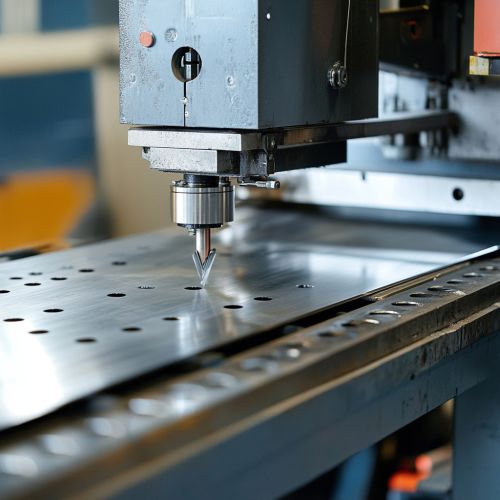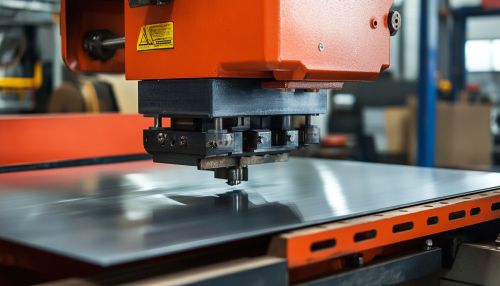Press Machine: Difference between revisions
(Created page with "== Introduction == A press machine, also known as a pressing machine, is a mechanical device used to shape or cut materials by applying pressure. These machines are integral to various manufacturing processes, including metalworking, plastic molding, and wood pressing. The primary function of a press machine is to exert a controlled force to deform, cut, or shape materials into desired forms. This article delves into the types, components, operations, and applications of...") |
No edit summary |
||
| Line 71: | Line 71: | ||
Press machines are also used in the production of consumer goods, including household appliances, furniture, and packaging materials. Stamping and forming processes are commonly used in this sector. | Press machines are also used in the production of consumer goods, including household appliances, furniture, and packaging materials. Stamping and forming processes are commonly used in this sector. | ||
[[Image:Detail-98071.jpg|thumb|center|Industrial press machine in operation, pressing a metal sheet.|class=only_on_mobile]] | |||
[[Image:Detail-98072.jpg|thumb|center|Industrial press machine in operation, pressing a metal sheet.|class=only_on_desktop]] | |||
== Safety Considerations == | == Safety Considerations == | ||
Latest revision as of 12:00, 22 September 2024
Introduction
A press machine, also known as a pressing machine, is a mechanical device used to shape or cut materials by applying pressure. These machines are integral to various manufacturing processes, including metalworking, plastic molding, and wood pressing. The primary function of a press machine is to exert a controlled force to deform, cut, or shape materials into desired forms. This article delves into the types, components, operations, and applications of press machines, providing a comprehensive understanding of their role in industrial manufacturing.
Types of Press Machines
Press machines can be categorized based on their mechanism, power source, and application. The main types include:
Mechanical Presses
Mechanical presses operate through a motor-driven flywheel that stores energy and releases it to drive the ram. These presses are known for their high-speed operation and precision. They are commonly used in stamping, punching, and forming operations.
Hydraulic Presses
Hydraulic presses utilize a hydraulic cylinder to generate compressive force. They are known for their ability to provide consistent pressure and are used in applications requiring high force over a longer stroke. Common uses include forging, molding, and deep drawing.
Pneumatic Presses
Pneumatic presses use compressed air to generate force. These presses are suitable for light-duty applications and are often used in assembly operations, where speed and ease of control are crucial.
Servo Presses
Servo presses are driven by a servo motor, allowing precise control over the ram's position, speed, and force. These presses are used in applications requiring high precision and flexibility, such as electronic component manufacturing.
Components of Press Machines
Press machines consist of several key components that work together to perform the pressing operation. These include:
Frame
The frame is the main structure that supports the press machine. It must be robust and rigid to withstand the forces generated during operation. Frames can be classified into C-frame and H-frame configurations.
Ram
The ram is the moving part of the press that applies force to the workpiece. It is driven by the press's power source and moves in a linear motion.
Bed
The bed is the stationary part of the press where the workpiece is placed. It must be flat and stable to ensure accurate pressing operations.
Power Source
The power source provides the energy required to drive the press. This can be an electric motor, hydraulic pump, or pneumatic system, depending on the type of press.
Control System
The control system regulates the press's operation, including the movement of the ram, the application of force, and safety mechanisms. Modern presses often use computerized control systems for precise operation.
Operations of Press Machines
Press machines perform various operations, each suited to specific manufacturing needs. The primary operations include:
Stamping
Stamping involves using a press to cut or shape metal sheets into desired forms. This process is widely used in the automotive and appliance industries.
Punching
Punching is a process where a press is used to create holes in a material. The punch, a tool attached to the ram, forces the material through a die to create the hole.
Bending
Bending operations involve deforming a material into a specific angle or shape. Press brakes are specialized press machines used for bending sheet metal.
Forming
Forming processes use press machines to shape materials without removing any material. This includes operations like drawing, where a sheet metal is stretched into a desired shape.
Forging
Forging involves using a press to deform metal into a desired shape through compressive forces. This process enhances the material's mechanical properties and is used in manufacturing components like gears and shafts.
Applications of Press Machines
Press machines are used in a wide range of industries due to their versatility and efficiency. Some key applications include:
Automotive Industry
In the automotive industry, press machines are used to manufacture various components, including body panels, engine parts, and transmission components. Stamping and forging are common processes in this sector.
Aerospace Industry
The aerospace industry utilizes press machines for manufacturing critical components such as turbine blades, structural parts, and fasteners. Precision and reliability are paramount in this industry.
Electronics Industry
Press machines play a crucial role in the electronics industry, where they are used to produce components like connectors, circuit boards, and enclosures. Servo presses are particularly valuable for their precision.
Construction Industry
In the construction industry, press machines are used to fabricate structural components, such as beams, columns, and brackets. Hydraulic presses are often employed for their high force capabilities.
Consumer Goods
Press machines are also used in the production of consumer goods, including household appliances, furniture, and packaging materials. Stamping and forming processes are commonly used in this sector.


Safety Considerations
Operating press machines involves significant risks, and safety measures are essential to prevent accidents. Key safety considerations include:
Machine Guarding
Machine guarding involves installing physical barriers to prevent operators from coming into contact with moving parts. Guards should be robust and properly maintained.
Emergency Stop Mechanisms
Emergency stop mechanisms allow operators to quickly halt the press in case of an emergency. These mechanisms should be easily accessible and regularly tested.
Training and Certification
Operators should receive thorough training and certification to ensure they understand the press machine's operation and safety protocols. Regular refresher courses are also recommended.
Maintenance and Inspection
Regular maintenance and inspection of press machines are crucial to identify and address potential issues before they lead to accidents. This includes checking for wear and tear, lubrication, and calibration.
See Also
References
- (Add references here if available)
